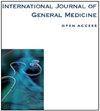SEMA5A 及其相关自噬基因在胃癌中的作用机制研究
IF 2
4区 医学
Q2 MEDICINE, GENERAL & INTERNAL
引用次数: 0
摘要
目的:SEMA5A(SEMA5A)和自噬相关基因(ARGs)在胃癌(GC)的发病机制中起着关键作用。然而,SEMA5A通过其相关的ARGs在自噬中的潜在调控作用及其潜在的分子机制仍悬而未决:分析癌症基因组图谱(The Cancer Genome Atlas,TCGA)和基因表达总库(Gene Expression Omnibus,GEO)中的GC相关数据集,以确定GC样本和对照样本之间的差异表达基因(DEGs)。DEGs与ARGs的交叉产生了候选基因,这些候选基因通过与SEMA5A的斯皮尔曼相关性进一步分析,以确定特征基因。根据特征基因的表达对 GC 样本进行分层,然后进行 Kaplan-Meier 生存分析,确定关键基因。随后对关键基因和 SEMA5A 进行了分析,包括基因组富集分析(GSEA)、免疫浸润和免疫检查点评估。使用实时定量聚合酶链反应(RT-qPCR)对 mRNA 表达水平进行量化:结果:90 个候选基因与 SEMA5A 存在 Spearman 相关性,其中 TNFSF11、BMP6、ITPR1 和 DLC1 的相关系数超过 0.3。由于预后差异显著,生存分析强调 DLC1 和 BMP6 是关键基因。GSEA显示,SEMA5A、BMP6和DLC1与ECM受体相互作用通路有关。免疫浸润分析表明,SEMA5A 和 BMP6 与 M1 巨噬细胞呈负相关,而 DLC1 与免疫检查点 PDCD1LG2 的相关性最强(p < 0.05, cor = 0.43)。与 GES-1 细胞相比,SEMA5A 的 mRNA 表达水平在 AGS 亲本细胞中明显上调(p <0.01),而与 GES-1 细胞相比,DLC1 和 BMP6 的 mRNA 水平在 AGS 亲本细胞中明显下调(p <0.0001):结论:发现了与SEMA5A相关的ARGs BMP6和DLC1,并证明了它们在GC中的预后意义。此外,通过免疫浸润分析和分子网络构建,进一步阐明了它们的调控机制,为今后研究GC患者的分子机制提供了理论基础:GC;SEMA5A;自噬;ARGs;生物信息学分析本文章由计算机程序翻译,如有差异,请以英文原文为准。
Investigation of the Mechanism of SEMA5A and Its Associated Autophagy-Related Genes in Gastric Cancer
Purpose: Semaphorin 5A (SEMA5A) and autophagy-related genes (ARGs) are pivotal in the pathogenesis of gastric cancer (GC). However, the potential regulatory role of SEMA5A in autophagy via its associated ARGs and the underlying molecular mechanisms remain unresolved.
Patients and Methods: GC-related datasets from The Cancer Genome Atlas (TCGA) and Gene Expression Omnibus (GEO) were analyzed to identify differentially expressed genes (DEGs) between GC and control samples. The intersection of DEGs with ARGs produced candidate genes, which were further analyzed using Spearman correlation with SEMA5A to identify signature genes. Stratification of GC samples based on signature gene expression, followed by Kaplan-Meier survival analysis, identified key genes. Subsequent analyses, including gene set enrichment analysis (GSEA), immune infiltration, and immune checkpoint evaluation, were conducted on the key genes and SEMA5A. The mRNA expression level was quantified using real-time quantitative polymerase chain reaction (RT-qPCR).
Results: Ninety candidate genes were identified for Spearman correlation with SEMA5A, revealing TNFSF11, BMP6, ITPR1, and DLC1 with correlation coefficients exceeding 0.3. Survival analysis underscored DLC1 and BMP6 as key genes due to significant prognostic differences. GSEA implicated SEMA5A, BMP6, and DLC1 in the ECM receptor interaction pathway. Immune infiltration analysis indicated a negative correlation of SEMA5A and BMP6 with M1 macrophages, while DLC1 exhibited the strongest association with the immune checkpoint PDCD1LG2 (p < 0.05, cor = 0.43). The mRNA expression level of SEMA5A was significantly upregulated in AGS parental cells compared to GES-1 cells (p < 0.01), whereas DLC1 and BMP6 mRNA levels were markedly downregulated in AGS parental cells relative to GES-1 (p < 0.0001).
Conclusion: ARGs BMP6 and DLC1, associated with SEMA5A, were identified, and their prognostic significance in GC was demonstrated. Additionally, their regulatory mechanisms were further elucidated through immune infiltration analysis and molecular network construction, providing a theoretical foundation for future research on the molecular mechanisms in patients with GC.
Keywords: GC, SEMA5A, autophagy, ARGs, bioinformatics analysis
Patients and Methods: GC-related datasets from The Cancer Genome Atlas (TCGA) and Gene Expression Omnibus (GEO) were analyzed to identify differentially expressed genes (DEGs) between GC and control samples. The intersection of DEGs with ARGs produced candidate genes, which were further analyzed using Spearman correlation with SEMA5A to identify signature genes. Stratification of GC samples based on signature gene expression, followed by Kaplan-Meier survival analysis, identified key genes. Subsequent analyses, including gene set enrichment analysis (GSEA), immune infiltration, and immune checkpoint evaluation, were conducted on the key genes and SEMA5A. The mRNA expression level was quantified using real-time quantitative polymerase chain reaction (RT-qPCR).
Results: Ninety candidate genes were identified for Spearman correlation with SEMA5A, revealing TNFSF11, BMP6, ITPR1, and DLC1 with correlation coefficients exceeding 0.3. Survival analysis underscored DLC1 and BMP6 as key genes due to significant prognostic differences. GSEA implicated SEMA5A, BMP6, and DLC1 in the ECM receptor interaction pathway. Immune infiltration analysis indicated a negative correlation of SEMA5A and BMP6 with M1 macrophages, while DLC1 exhibited the strongest association with the immune checkpoint PDCD1LG2 (p < 0.05, cor = 0.43). The mRNA expression level of SEMA5A was significantly upregulated in AGS parental cells compared to GES-1 cells (p < 0.01), whereas DLC1 and BMP6 mRNA levels were markedly downregulated in AGS parental cells relative to GES-1 (p < 0.0001).
Conclusion: ARGs BMP6 and DLC1, associated with SEMA5A, were identified, and their prognostic significance in GC was demonstrated. Additionally, their regulatory mechanisms were further elucidated through immune infiltration analysis and molecular network construction, providing a theoretical foundation for future research on the molecular mechanisms in patients with GC.
Keywords: GC, SEMA5A, autophagy, ARGs, bioinformatics analysis
求助全文
通过发布文献求助,成功后即可免费获取论文全文。
去求助
来源期刊

International Journal of General Medicine
Medicine-General Medicine
自引率
0.00%
发文量
1113
审稿时长
16 weeks
期刊介绍:
The International Journal of General Medicine is an international, peer-reviewed, open access journal that focuses on general and internal medicine, pathogenesis, epidemiology, diagnosis, monitoring and treatment protocols. The journal is characterized by the rapid reporting of reviews, original research and clinical studies across all disease areas.
A key focus of the journal is the elucidation of disease processes and management protocols resulting in improved outcomes for the patient. Patient perspectives such as satisfaction, quality of life, health literacy and communication and their role in developing new healthcare programs and optimizing clinical outcomes are major areas of interest for the journal.
As of 1st April 2019, the International Journal of General Medicine will no longer consider meta-analyses for publication.
 求助内容:
求助内容: 应助结果提醒方式:
应助结果提醒方式:


